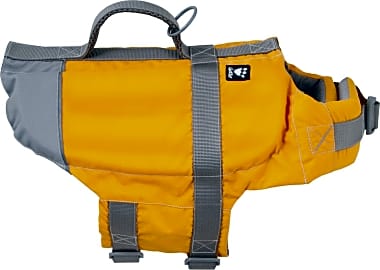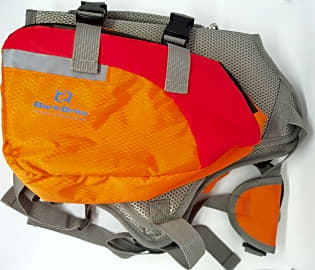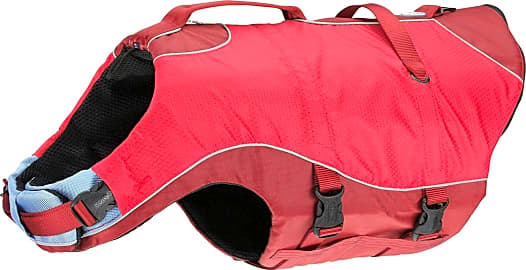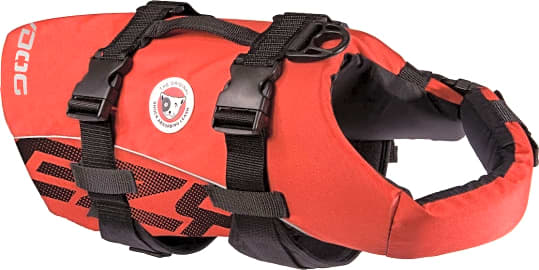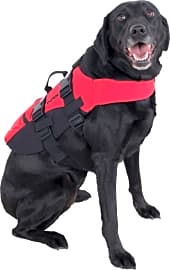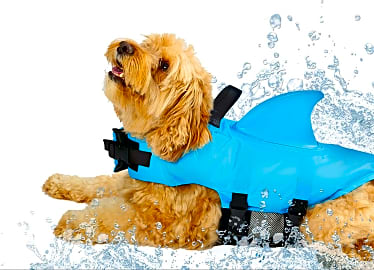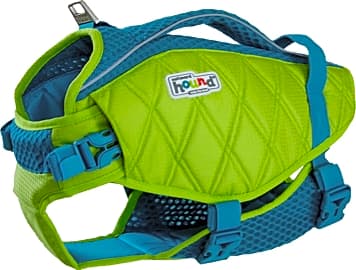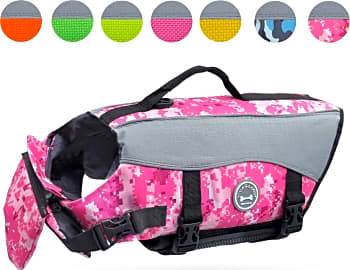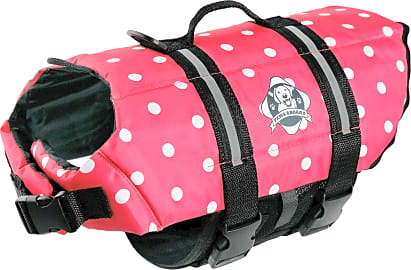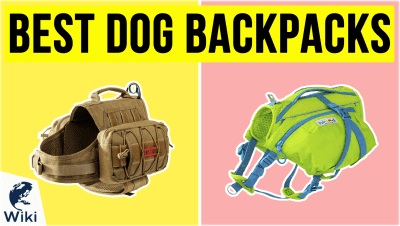The 10 Best Dog Life Jackets

This wiki has been updated 40 times since it was first published in July of 2015. Whether it's for recreational swimming at the beach, canine rehabilitation, or aquatic rescue, ensure Fido's safety in any lake, ocean, or swimming pool environment by fitting him with one of these sturdy dog life jackets before he jumps into the water. Their interior foam layers are designed to provide plenty of buoyancy, while also remaining flexible enough for unrestricted movement on land. When users buy our independently chosen editorial selections, we may earn commissions to help fund the Wiki.
Editor's Notes
May 24, 2019:
Buoyancy and ease of control are both important values to consider with any dog life jacket. The accessory should have plenty of internal padding to keep Fido comfortable and shaped in a way that allows the dog to keep his head above water as well. Reflective striping is also beneficial if you plan to go boating with your pup at night.
I maintained the Ruffwear Float Coat due to its adjustable telescoping neck closure and closed-cell foam panels for ensuring freedom of movement. The extra padding across the back and chest of the Hurtta Life Savior makes it a valuable addition to the list, as it helps to keep a dog's head out of the water. It also comes with an integrated name tag in case a pet gets lost. I thought the Bark Brite Multipurpose was worthy of inclusion, as it can be used as both a life jacket and a backback, while the quick-drying mesh layer makes it perfect for both swimming and outdoor treks in the rain. The removable inner liner of the Kurgo Surf N Turf allows it to double as both a life jacket and raincoat, while the ripstop polyester outer layer can withstand high-energy output from particularly large breeds. I decided to add the NRS Canine Flotation Device because of its 1000-denier Cordura fabric, reflective safety tape for nighttime visibility, and multiple adjustment points. Maintained the Swimways Sea Squirts for its cute (and easy-to-grab) shark design, which is ideal for smaller breeds. Finally, I also maintained the Outward Hound Standley Sport for its durability and double handles and mesh-style belly band for quick water drainage.
Barking And Buoyancy
The life jacket is important in situations when constant monitoring of a dog proves difficult.
A life jacket for a dog operates on the same principles as a personal flotation device does for humans, being that it is a simple piece of wearable equipment that gives the dog buoyancy in the water, while protecting the animal from swimming fatigue, possible water intoxication, or drowning.
Two types of PFDs for dogs include life jackets and life vests. The life jacket normally covers a dog's entire body and is designed for use on a boat or at the beach. Should a pet fall off a boat or be carried by an ocean current, the jacket will help to keep the dog afloat for quick rescue. These types of jackets are often sold in bright colors (e.g. reds and yellows), which make the animal easy to spot. They are also equipped with grabbing handles on the back to assist in hoisting a dog out of the water during retrieval.
The life jacket is important in situations when constant monitoring of a dog proves difficult. However, it's never a good idea to leave a pet unsupervised in the water for any length of time. The life vest is designed more for recreational swimming in a pool and for exercise than it is for ocean swimming.
Similar to flotation devices designed for humans, dog life jackets are often constructed from closed cell foam due to its low weight, high density, and ability to comfortably wrap around a dog's torso and neck to keep the animal's head above water. Dog life jackets come in a variety of sizes and most have adjustable straps for accommodating any range of breeds from small to large. Automatic, inflatable life jackets provide additional buoyancy, while remaining less bulky than their traditional passive counterparts, but they are less common and typically more expensive than conventional life jackets.
It's easy to assume that a pet has amazing stamina to overcome the difficulties of the elements better than a human could. This might make a person wonder whether their dog would even need a life jacket in the first place. The fact is that while a dog does have strength, he is just as vulnerable to fatigue, confusion, and accidents as people are. For that reason, the dog life jacket serves many benefits. Some breeds have considerably less body fat than others, making it more difficult to stay afloat. The life jacket provides the extra buoyancy needed to ensure a pet's safety.
For puppies and older dogs with less stamina, the jacket offers additional assurance that they can remain afloat if they get too tired. Dogs are also preprogrammed with certain primal instincts, whether it's hunting, chasing, or jumping. If the pet is on a boat and sees a duck in the water, his instinct takes over. It may seem like he's possessed to go after the water fowl. In such an unanticipated circumstance, the dog may forget about his own muscles, the temperature of the water, or the fact that he's getting tired, leading to a potentially dangerous outcome. If he's at least covered with a flotation device like a life jacket, it's easy enough to retrieve him.
Keeping Your Pup Safe In The Water
Whatever life jacket you choose to invest in, it should have a sturdy grabbing handle. This will make lifting an adult, large-breed dog out of the water much easier. Pay attention to the location of a jacket's straps and buckles. While safety is important, your dog should also be comfortable and not have its mobility restricted when out of the water.
Depending on the size of the dog and jacket, many will offer a range of adjustments, which can be helpful for a growing puppy. Making sure the jacket is durable and packed with plenty of foam and other buoyant materials will also be integral to the pet's safety.
A life jacket with reflective tape and bright colors affords you the freedom and peace of mind to go boating with your furry friend at night. This way, you'll always see him should he happen to be splashing in the water after the sun goes down, regardless of whether he's in the ocean or a swimming pool.
A Brief History Of The Dog Life Jacket
Life jackets in their most primitive form appeared at the beginning of the 19th century when purpose-designed safety devices made from blocks of wood and cork were used by Norwegian seamen. One of the first cork life jackets was available for sale in 1804.
One of the first cork life jackets was available for sale in 1804.
The invention of the modern life jacket is credited to Captain Ward, an inspector for the Royal National Lifeboat Institution of the United Kingdom in 1854. This first jacket was worn by lifeboat crews for weather protection and buoyancy. In 1900, French electrical engineer and inventor Gustave Pierre Trouvé invented the first battery-powered life jacket that leveraged rubber-insulated electric batteries to both inflate the device and power its SOS receiver and transmitter light.
As development of the jacket technology evolved over time, cork material was eventually replaced by pouches with watertight cells filled with a vegetable material known as kapok. These cells were flexible and more comfortable to wear than cork material. Around the time of World War Two, foam replaced kapok.
Life jackets specifically designed for dogs were not introduced, nor did they gain popularity, until the mid-1990s, at which point they became available in pet shops, marine supply stores, and on the internet. Today, life jackets for dogs are available in a variety of colors and inflatable options, including auto-inflatable devices designed to keep a pet horizontally balanced in the water.


